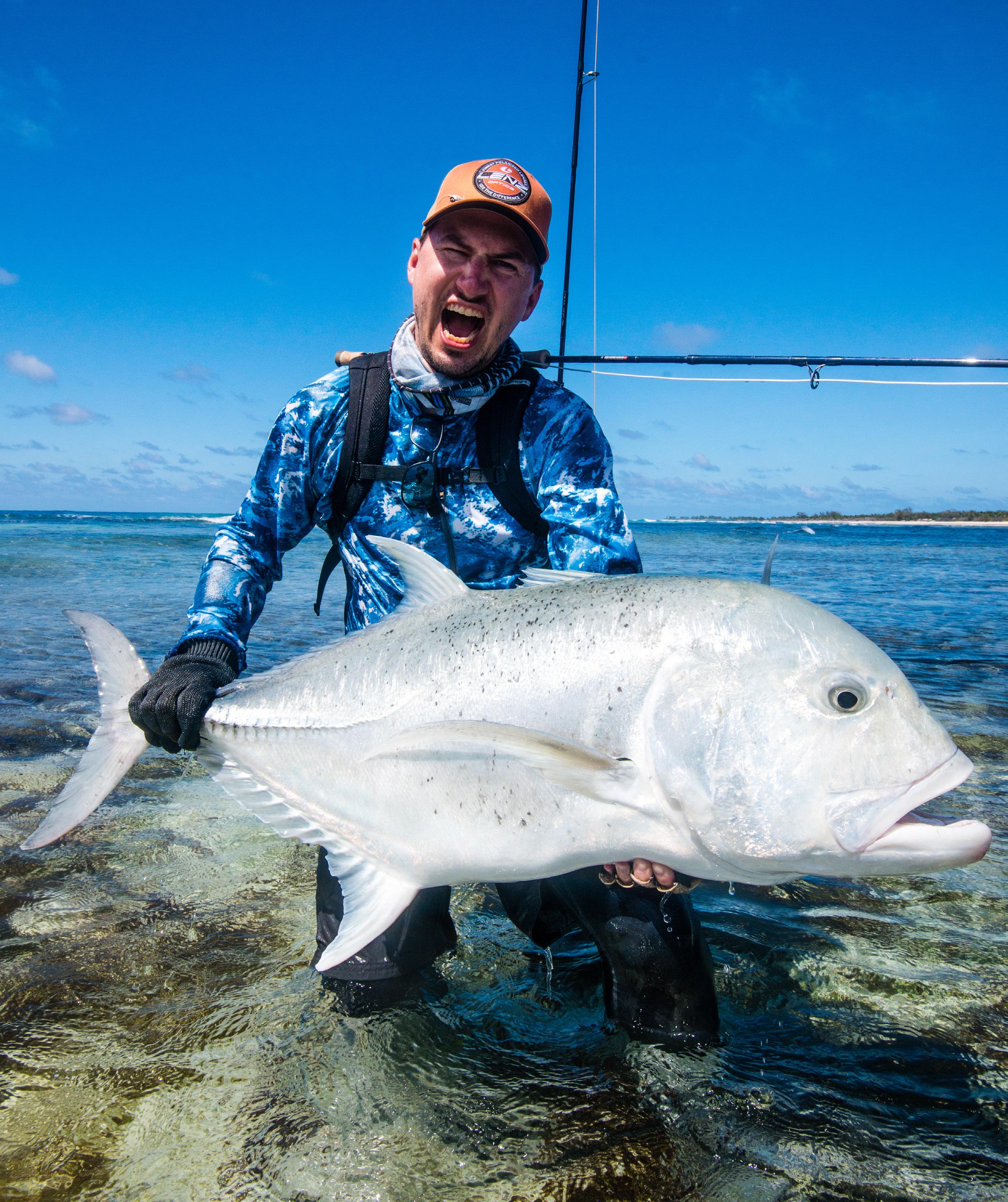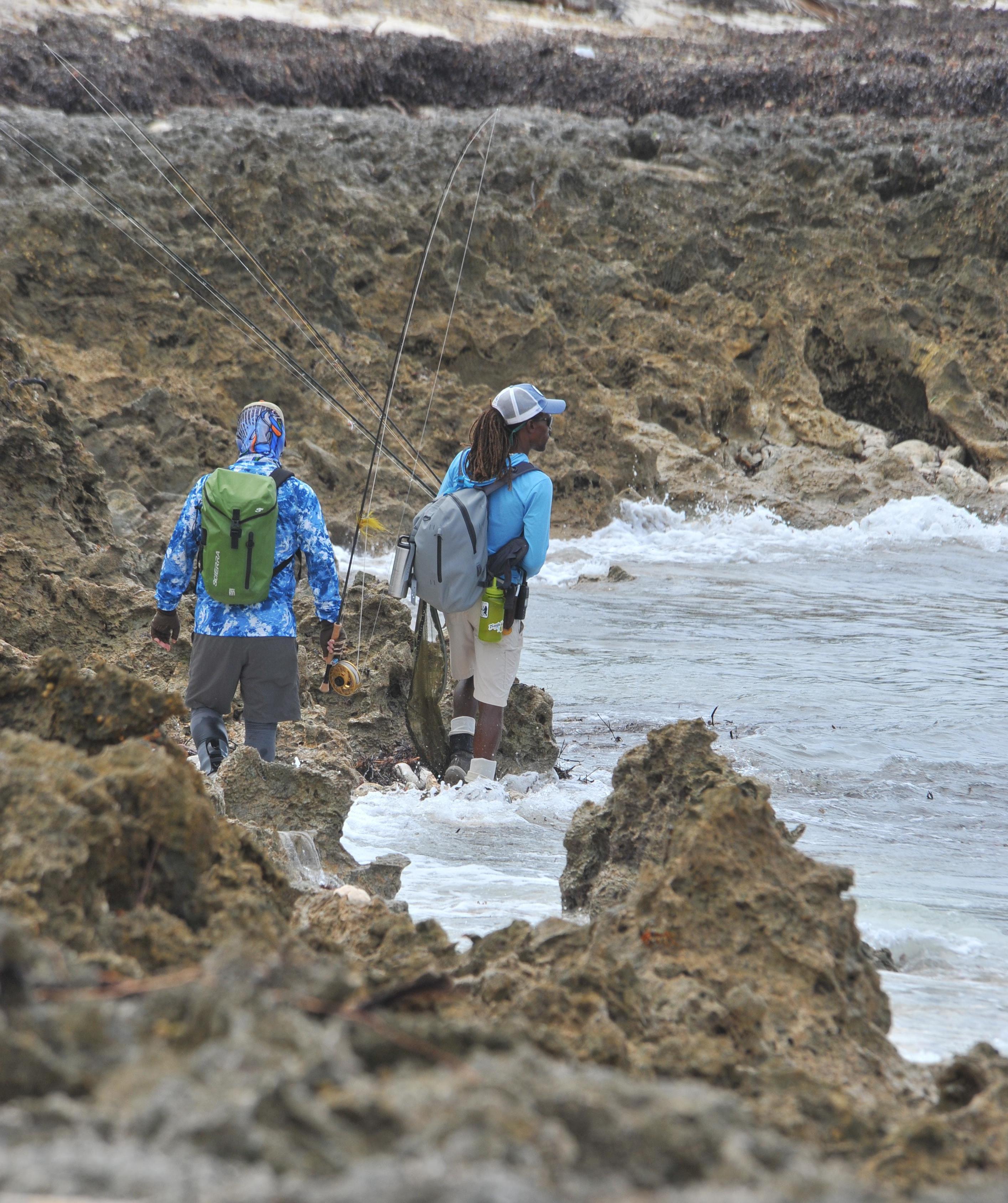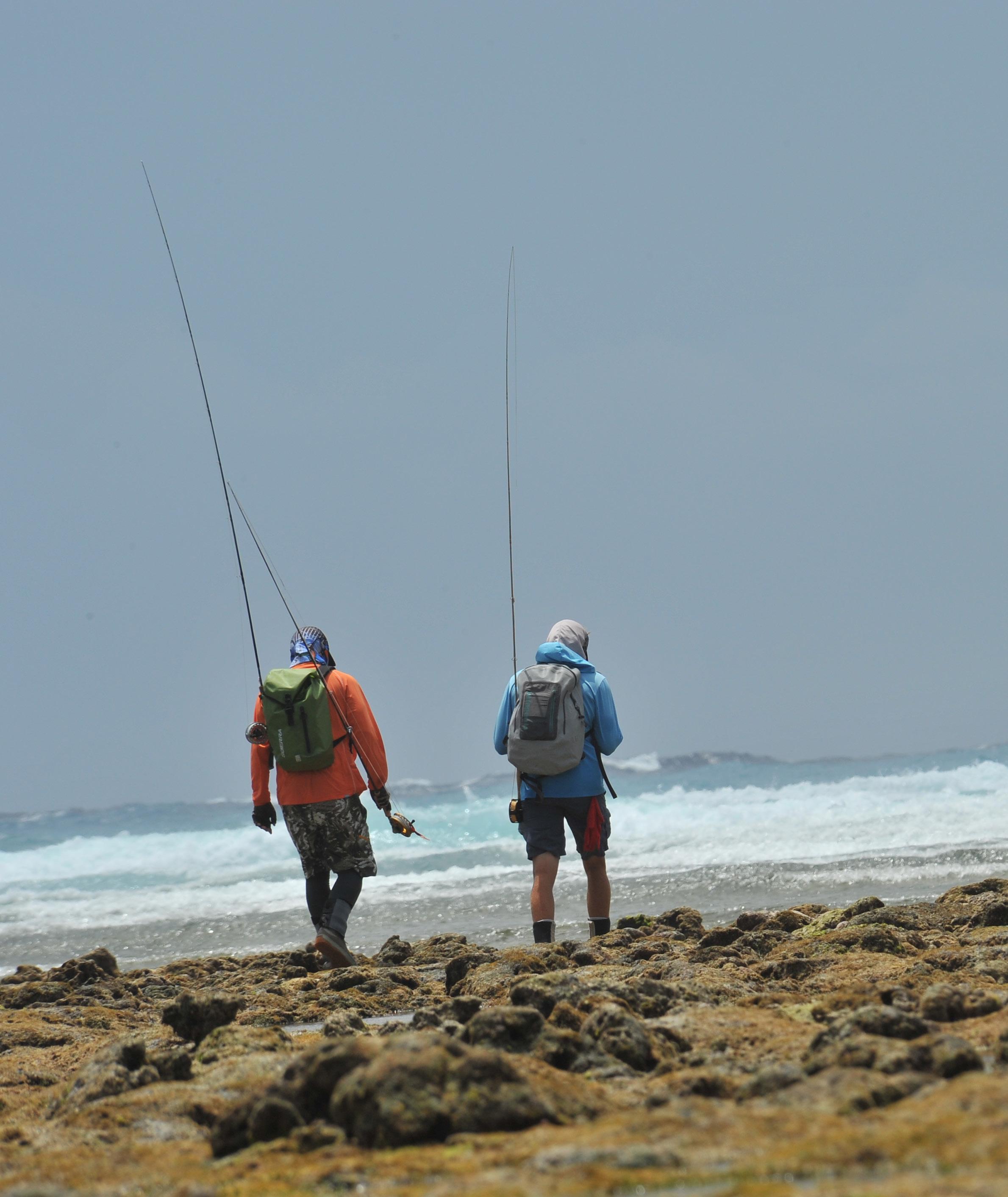
8 minute read
Astove Atoll: Fly Fishing for the Masters of Destruction - Pt II
Are you dreaming about traveling to the Seychelles to fly fish for GT’s, permit, triggerfish and bonefish? If so, you should check out Astove Atoll. In the following, we’ll provide you with all the info needed to plan a trip there.
By: RASMUS OVESEN Photos by: RASMUS OVESEN, MARTIN EJLER OLSEN and KYLE REED

Continued from last issue…
Astove Atoll is situated in the Indian Ocean, due north of Madagascar and some 1000 kilometres southwest of Mahé, which is the main island in the Seychelles.
The atoll offers a rare glimpse into a world, which has changed very little over the years passed. It’s a place of rare beauty, where the daily dramas of a pristine and virtually untouched ecosystem play out vividly in front of your eyes.
Wild pigs and goats roam the island as do huge tortoises and colourful terrestrial crab species. Several endemic species of birds can also be seen darting about in the tree tops and palm trees among colourful butterflies, but it isn’t until one has a look below the water surface that one realises just how prolific the wild life is.
The flats, lagoon and reefs are teeming with life, and along the Astove Wall, which is best described as gazing down into the Grand Canyon, you’re likely to see anything from huge sharks, sea turtles and dolphins to sailfish, rays, barracuda and wahoo. The Astove Wall consists of the large flats and reef dropping a vertical 90 degrees, from knee-deep water to an abysmal depth of a kilometre.
No wonder that the famous and acclaimed marine pioneer, Jacques Cousteau, shot his underwater documentary “The Silent World” here!

Lodging
Astove Atoll caters to an exclusive six fly fishermen per week, and the season extends from November to December and March to April. The newly renovated lodge offers full-catering service, exquisite Creole cuisine, and accommodation in single air-conditioned en-suite rooms.
If you’re interested in booking a trip to Astove Atoll, or some of the other renowned Alphonse Fishing Co destinations in the Seychelles – including Cosmoledo, Alphonse Island and Poivre, send an email to:
reservations2@alphonsefishingco.com
For further information, be sure to check out these links:
http://www.alphonsefishingco.com http://www.seychelles.travel/
Transport and logistics
The transportation to Astove Island is usually via Dubai to Mahé and Seychelles International Airport. Here, Emirates is an obvious choice, seeing as they have regular flights with appropriate arrival times in relation to the journey onwards:
http://www.emirates.com
The plane to Astove Atoll leaves early in the morning, and as a result you’ll need an overnight stay in Mahé. We found the villas at Eden Island, which is close to the airport, to be very charming, comfortable and relaxing. Eden Island offers beautiful, newly-built apartments, maisons, and villas situated on its own gated island with ambient marinas, cosy cafes, a shopping center, and a view to the ocean along with pearly white, palm-ridden sand beaches. When time permits, Eden Island is also a great starting point for discovering Mahé, the Seychellois capital. For more information, please check:
http://www.edenbleu.com
For transportation services to and from the airport, logistics or tourism requests, Creole Travel Services is your point of reference:
http://www.creoletravelservices.com
You’ll continue your journey to Astove Atoll on a 3-hour IDC flight arranged by Alphonse Fishing Co. It departs from the IDC Hangar outside the International Airport, and getting there involves a five-10-20minute taxi-ride.
Depending on your itinerary, you might experience a good deal of layover in Dubai International Airport on your way back, and it might therefore be a good idea to get some rest in the Dubai International Airport Hotel, which is conveniently located inside the departure terminal:
https://www.dubaiintlhotels.com/
The Fishing
If you’re in the market for targeting the biggest flats-caught giant trevallies in the Indian Ocean, Astove Atoll is the place to be.
Its shallow lagoon, jagged coastline and endless flats surrounded by sheer drop-offs provides the giant trevally with a unique and versatile feeding habitat and, as a result, giant trevallies are extremely abundant.
Besides GTs, Astove Atoll boasts trophy-sized bonefish, bluefin trevally, triggerfish, barracuda, milkfish and Indo-pacific permit. And if one ventures offshore, one can catch yellowfin tuna, dogtooth tuna, wahoo, groupers, sailfish and much, much more - just meters from the coral reef edge.
Gear and Equipment
Since the species diversity at Astove Atoll is quite overwhelming, you’ll need a versatile range of tropical fly rod-and-reel setups. You’ll generally need a minimum of four setups:
An 8-weight setup for bonefish and triggerfish, a 10-weight setup for permit and milkfish, and two 12-weight setups for giant trevally – all of them pre-spooled with tropical floating lines. The reason why it’s a good idea to have an extra 12-weight setup on you at all times is that it enables you to switch quickly between poppers and streamers when sight-fishing for giant trevally. Furthermore, because giant trevallies are known for breaking rods, melting down reel drag systems and emptying backing reserves, a backup 12-weight setup is essential.
While the gear required for bonefish, triggerfish, milkfish and permit is similar to that used elsewhere in the tropics, the gear needed for giant trevally is in its own league. Here, you’ll need the very best saltwater fly rods in combination with a fly reel that can stop a span of wild horses.
I found the Scott Meridian rods and Waterworks-Lamson reels (including the Cobalt) to do the job beautifully!
As a life-insurance during the utter mayhem and chaos of a giant trevally outburst you’ll need a minimum of 300 meters of 80lb backing in combination with a specially designed fly line – such as Scientific Angler’s 100lb test Sonar fly lines. The fly line is then linked to the fly via a 2-meter long 100 – 130lbs fluorocarbon tippet. It may sound completely out of proportion, but it is all due to the fact that a giant trevally needs to be treated with extreme strictness and maximum pressure during the fight. Otherwise, they will run off and you’ll risk getting spooled or being cut off on corals and other subaqueous structure.
The flies, that are most commonly used at Astove Atoll, are specifically designed and developed for the fishing here. Fulling Mill, in England, have launched a series of flies developed in close cooperation with the guides at Alphonse Fishing Co, and they can be found here:





The giant trevallies are fished with either NYAP poppers or gnarly streamers tied on the strongest possible 6/0 – 8/0 saltwater hooks like the Gamakatsu SL12s. They should be bulky, pulsating and have big, staring eyes – and it’s an advantage if they’re made out of materials that don’t suck in too much water. Among the local favourites are the Brush Fly, GT Mullet, Bus Ticket and Serge’s Wrasse.
When it comes to wading equipment, clothing and such, you can pack like you normally would for similar tropical trips. Otherwise, Alphonse Fishing Company provides in-depth information about what to bring prior to the visit at Astove Atoll.
Giant Trevally (Caranx Ignobilis)
The Giant Trevally – or GT - is a member of the jack family, Carangidae – a family of aggressive predatory fish distributed throughout the tropical waters of the Indo-Pacific region. GTs are found across the marine range stretching from South Africa to Hawaii including Japan in the north and Australia in the south, and although they sometimes school up, they are predominantly solitary predators.


Phenotypically, the giant trevally is recognized by its rather steep head profile, ovate and moderately compressed body, protruding eyes, powerful tail scutes, its spiny dorsal fin and strongly forked cordal fin. It varies in colour from a charcoal black to a silvery colour with occasional dark spots and discrete marblings. They are broad-shouldered and muscular fish that are capable of both explosive bursts and long-distance surges.
Size-wise, GTs have been recorded up to 170cm in length and weights in excess of 80 kilos. However, a 50lb+ fish caught on a fly rod is considered a trophy. They are ferocious apex predators that grow relatively fast, reaching sexual maturity at the age of roughly three years and 60 cm in length, and it is believed that they can grow to about 25 years of age.
GTs inhabit a very wide and varied range of offshore and inshore marine environments, but the biggest individuals seem to prefer deeper seaward reefs and drop-offs with good structure and diverse forage resources. They will, however, patrol shallow water on occasion both for hunting and reproductive purposes.
GTs primarily feed on other fish such as bonefish, mullet, snappers and eels – but they will also feed on squid, shrimp, crab, lobster and even birds and turtles.
Are you dreaming about traveling to the Seychelles to fly fish for GT’s, permit, triggerfish and bonefish? If so, you should check out Astove Atoll. In the following, we’ll provide you with all the info needed to plan a trip there.










